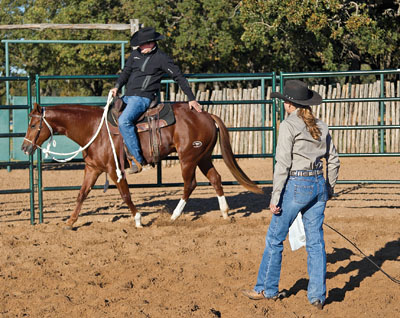What can taming a wild horse teach you about starting a domestic colt? Plenty—just ask Clinton Anderson, who’s tamed more than a few mustangs and outlaws over the years, plus presented popular clinics and DVDs on colt-starting. The important part of colt-starting though is staying safe.

Here are five key tips Clinton offers from his years of experience–as backed up by his amazing 2013 outback adventure taming a wild brumby in Australia:
#1: Prepare with groundwork. Never be in a hurry to get on, says Clinton. “If you have to spend two weeks or more preparing your colt for that very first ride, do it,” he stresses. “When I was young and learning the ropes, every time I was bucked off it was because I did a poor job of preparing for that first ride. As my mentor Ian Francis used to say, ‘There are a lot of heroes in the graveyard’–meaning people who get on a colt before he’s fully prepared and get bucked off. Don’t be one of those.”
#2: Use a knowledgeable helper. For that critical first ride, at a minimum, enlist someone who’s experienced with horses to help you. Clinton’s method employs a helper who uses a flag to direct and distract the colt as need be.
#3: Have a dress rehearsal. You and your helper must be able to communicate fluently during that first ride, so plan in advance exactly how it will go. “Hold a dress rehearsal, using an old, broke horse to practice together as a team,” advises Clinton. “Run through everything you’ll do with the colt so you can get your communication down pat and won’t be caught off guard.”
#4: Doublecheck your cinch before you get on. This one seems like a no-brainer, but it bears emphasizing. Tighten up the cinch in stages, and afterwards don’t immediately step up on your colt’s back. “Sometimes when you snug up the cinch, the colt will get tight through his body and will carry that tension until he starts moving his feet,” the clinician explains. “So direct his feet around in a circle or two after tightening the cinch to make sure he’s freed up and relaxed before you get on.”
#5: Stay loose. Clinton says the single best piece of advice he can give to anyone riding a colt for the first time is to stay loose in the saddle and move around a lot—almost as if you’ve been drinking! “Teach him from day one that he needn’t be alarmed when he sees and feels you on top of him, rubbing him and moving all over him. I don’t care how tightly you hang onto the saddle horn as long as you keep the rest of your body completely relaxed.” He adds that you should always be prepared to slide your hand down one rein to draw your colt’s head around and stop him in case he tries anything. “You only get one body and you have to take care of it,” he insists. “Always remember: safety first.”






